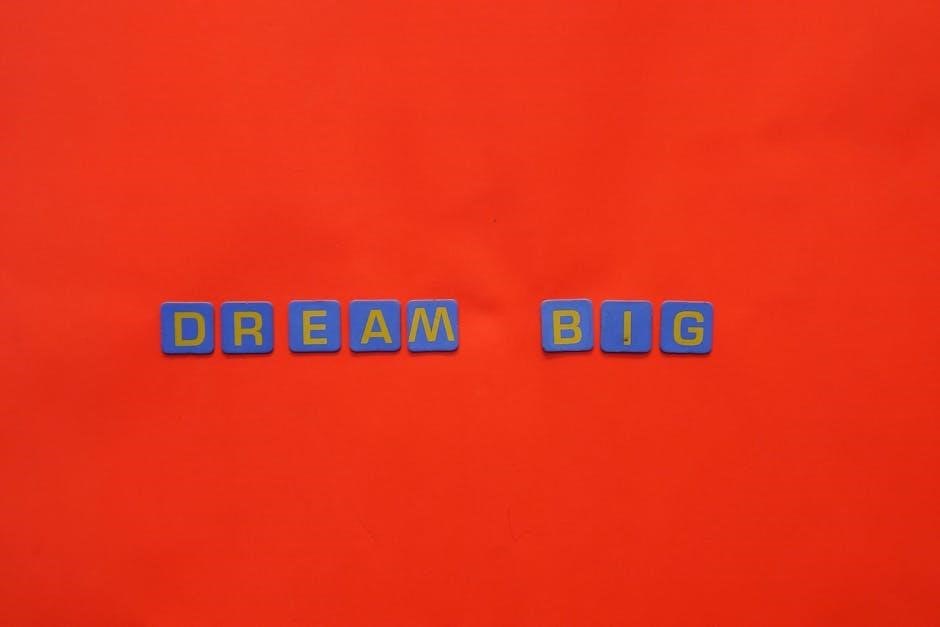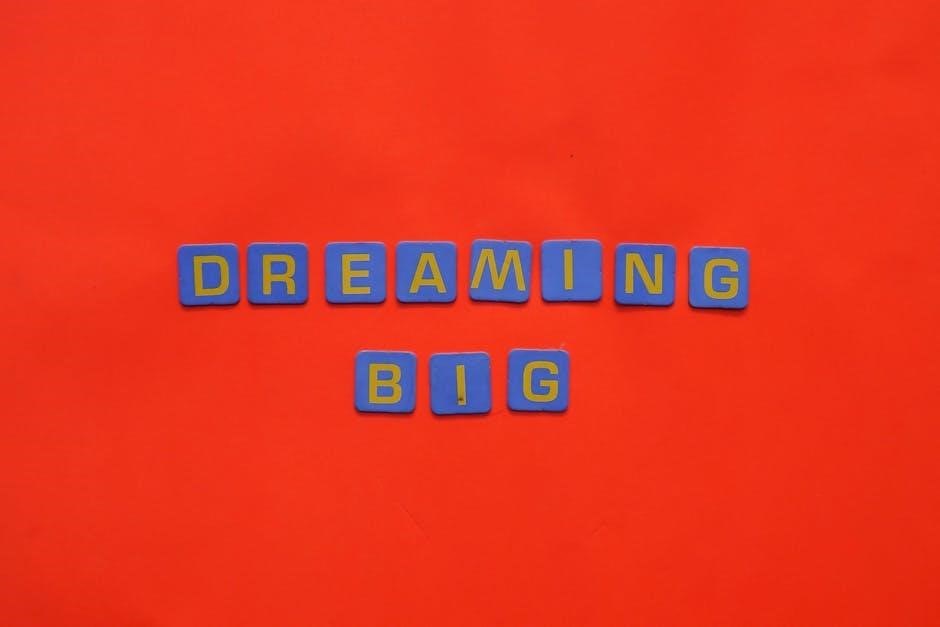Martin’s Big Words by Doreen Rappaport, illustrated by Bryan Collier, explores Dr. Martin Luther King Jr.’s life, emphasizing his powerful words and nonviolent protests for equality and justice.
1.1 Overview of the Book
Martin’s Big Words: The Life of Dr. Martin Luther King Jr. by Doreen Rappaport is a compelling picture book that introduces children to Dr. King’s life and legacy. The story highlights his journey from childhood to leadership, emphasizing his belief in the power of words and nonviolent protests. Illustrated by Bryan Collier, the book uses Dr. King’s own quotes to inspire young readers about equality, justice, and courage. Suitable for early learners, it connects his “big words” to real-world impact, making it a valuable resource for teaching social justice and history. Available as a PDF, it includes activities for deeper engagement.
1.2 Author and Illustrator Background
Doreen Rappaport, the author of Martin’s Big Words, is a celebrated children’s book writer known for her engaging storytelling and commitment to sharing inspiring true stories. Bryan Collier, the illustrator, brings the narrative to life with his powerful collages, blending historical and symbolic elements. Together, they create a vivid portrayal of Dr. King’s journey, making complex themes accessible to young readers. Their collaboration ensures the book is both educational and visually striking, earning it widespread acclaim and numerous awards. Rappaport’s text and Collier’s art seamlessly weave together to honor Dr. King’s legacy.
1.3 Key Themes and Messages
Martin’s Big Words explores themes of equality, justice, and the power of nonviolent resistance. The book highlights Dr. King’s belief in the transformative impact of words and actions. It emphasizes the importance of standing up for what is right, even in the face of adversity. The story also underscores the value of perseverance and the idea that one person can inspire meaningful change. By weaving Dr. King’s own words throughout the narrative, the book empowers young readers to think critically about their role in creating a better world and fostering equality for all.

The Life of Dr. Martin Luther King Jr.
Dr. Martin Luther King Jr. was a prominent leader in the civil rights movement, born on January 15, 1929, in Atlanta, Georgia, and assassinated in 1968.
2.1 Early Life and Influences
Dr. Martin Luther King Jr. was born on January 15, 1929, in Atlanta, Georgia, to Reverend Martin Luther King Sr. and Alberta Williams King. His father, a Baptist minister, and mother, a schoolteacher, instilled in him a strong sense of faith and social justice. Growing up in a segregated society, Martin experienced racism early in life, which shaped his determination to fight for equality. His education at Morehouse College and Crozer Theological Seminary deepened his commitment to nonviolent resistance, influenced by figures like Mahatma Gandhi. These early experiences laid the foundation for his leadership in the civil rights movement.
2.2 Martin’s Journey to Leadership
Martin Luther King Jr.’s journey to leadership began with his education and early experiences. He attended Morehouse College, where he developed his oratory skills, and later studied theology at Crozer Seminary. Influenced by Mahatma Gandhi’s philosophy of nonviolent resistance, Martin adopted this approach in his advocacy for civil rights. His leadership emerged during the Montgomery Bus Boycott, sparked by Rosa Parks’ act of defiance. Through powerful speeches and unwavering commitment, Martin became a central figure in the civil rights movement, inspiring others to join the fight for equality and justice.
2.3 The Power of Words in His Life
Dr. Martin Luther King Jr.’s words were a powerful tool for justice and equality. From his early sermons to iconic speeches like “I Have a Dream,” his ability to inspire and unite through language was unparalleled. His education and deep understanding of scripture and philosophy shaped his eloquence. King’s words not only reflected his vision for a better world but also mobilized millions to action. The book Martin’s Big Words highlights how his speeches and writings continue to resonate, emphasizing the enduring impact of his message of love and nonviolent resistance;
Educational Resources and Lesson Plans
Martin’s Big Words offers comprehensive educational resources, including study unit worksheets, comprehension strategies, and classroom activities, helping teachers integrate Dr. King’s legacy into engaging lessons for students.
3.1 Classroom Activities Inspired by the Book
Classroom activities inspired by Martin’s Big Words include creating murals and bulletin boards that visually represent Dr. King’s “big words” and their meanings. Students can draw scenes from their lives that reflect equality and justice. Teachers can also incorporate photo projects where students arrange images into large letter formations. Additionally, interactive comprehension strategies, such as “read and retell,” encourage students to sequence events from the text. These activities foster creativity, critical thinking, and a deeper connection to Dr. King’s legacy, helping students understand the power of words in shaping a better world.
3.2 Study Unit Worksheets for Teachers
Study unit worksheets for Martin’s Big Words provide teachers with comprehensive tools to enhance student learning. These resources include chapter-by-chapter comprehension questions, vocabulary challenges, and creative reading response activities. Teachers can also find tests to assess understanding and projects to encourage deeper engagement with the material. Additionally, the worksheets offer discussion guides and reflection prompts to help students connect Dr. King’s legacy to their own lives. These resources are designed to support educators in creating engaging and meaningful lessons, ensuring students grasp the book’s themes and messages effectively.
3.3 Comprehension Strategies for Students
To enhance understanding of Martin’s Big Words, teachers can employ several comprehension strategies. Before reading, students can preview the book by examining the cover and making predictions. During reading, stopping to discuss key vocabulary and concepts helps clarify meanings. After reading, activities like drawing scenes from the story or writing reflections encourage deeper thinking. Additionally, students can identify and discuss “big words” from Dr. King’s speeches, exploring both their literal and figurative meanings. These strategies help students connect with the text and grasp its significance, fostering a stronger understanding of Dr. King’s life and message.

The Big Words Concept
The term “big words” in Martin’s Big Words refers to Dr. King’s powerful speeches and ideas, blending literal meanings with figurative expressions of hope and justice.
4.1 Literal and Figurative Meanings of “Big Words”
The phrase “big words” in Martin’s Big Words carries dual significance. Literally, it refers to Dr. King’s powerful speeches and quotes that inspired a nation. Figuratively, it symbolizes the profound impact and depth of his message, emphasizing equality, justice, and hope. The book highlights how these “big words” were not just eloquent but transformative, shaping a movement and leaving a lasting legacy. Through this lens, students can explore how language can influence change and inspire others. The concept encourages reflection on the power of words in driving societal transformation and personal growth.
4.2 How Dr. King’s Words Impacted Society
Dr. Martin Luther King Jr.’s words, as highlighted in Martin’s Big Words, profoundly shaped society. His speeches and writings ignited the Civil Rights Movement, advocating for racial equality and justice. Through nonviolent protests and powerful rhetoric, he inspired widespread change, leading to landmark legislation like the Civil Rights Act. His messages of love, unity, and resilience continue to resonate, influencing modern social justice movements. The book underscores how Dr. King’s words not only challenged systemic oppression but also united people across races, fostering a vision of a more equitable future. His impact remains a cornerstone of American history and global human rights efforts.
Art and History Connections
Connect the story to art by creating murals or bulletin boards illustrating Dr. King’s big words. Students can draw scenes from their lives reflecting these ideas, fostering creativity and historical understanding.

5.1 Bulletin Board and Mural Ideas
Engage students with visual projects inspired by Dr. King’s legacy. Create a bulletin board or mural featuring his “big words” like equality, justice, and love. Use photos and drawings to form large letters, symbolizing the impact of his messages. Students can illustrate scenes from their lives that reflect these ideas, fostering creativity and connection to the story. Incorporate a timeline of key events alongside quotes, making the display both educational and artistic. This activity encourages students to visually express their understanding of Dr. King’s vision and its relevance to their own experiences.
5.2 Timeline of Important Events in Dr. King’s Life
Create a timeline highlighting key moments in Dr. Martin Luther King Jr.’s life, such as his birth in 1929, leadership in the Montgomery Bus Boycott, and iconic “I Have a Dream” speech. Include events like the March on Washington and the Memphis Sanitation Workers’ Strike. Use visuals and quotes from Martin’s Big Words to connect his actions to his powerful messages. This activity helps students understand the chronology of his journey and the significance of his contributions to civil rights and social justice. It bridges history with the themes explored in the book.

Guide for Educators and Parents
Provide educators and parents with strategies to effectively teach and discuss “Martin’s Big Words.” Offer practical advice on integrating the book into lesson plans, fostering meaningful discussions, and creating engaging activities that align with the book’s themes.”
Engage students with pre-reading discussions on Dr. King’s life and the concept of “big words.” During reading, pause to ask questions and encourage reflections. After reading, organize activities like drawing scenes from the book or creating timelines of Dr. King’s life. These exercises help deepen comprehension and connect the story to real-world applications, fostering critical thinking and creativity while honoring Dr. King’s legacy.” Encourage students to reflect on Dr; King’s words and their relevance to modern life. Guide discussions by asking open-ended questions about equality, justice, and courage. This fosters critical thinking and empathy. Students can share personal experiences or thoughts on how they might make a difference. Group discussions or reflective writing activities help deepen understanding and connection to the material, inspiring students to think about their own “big words” and actions for positive change, aligning with Dr. King’s legacy of impactful leadership and social transformation. Martin’s Big Words leaves a lasting legacy, inspiring future generations to embrace Dr. King’s vision of equality and justice through the power of words and actions. Dr. Martin Luther King Jr.’s legacy endures as a testament to the power of courage and vision. His “big words” continue to inspire generations, championing equality and justice. Through nonviolent protest, he reshaped America, leaving an indelible mark on civil rights history. Martin’s Big Words captures his journey, teaching children the value of standing up for what is right. King’s impact extends beyond his time, reminding us that one person’s voice can spark profound change. His legacy lives on in the ongoing fight for fairness and unity, proving that words can truly change the world. Teaching “big words” in classrooms is essential for fostering empathy, critical thinking, and social awareness. Martin’s Big Words provides a powerful tool to introduce students to Dr. King’s vision of equality and justice. By exploring his words, teachers help students connect with history and understand the impact of language on societal change. This approach not only enhances literacy skills but also encourages students to reflect on their own roles in creating a better world. Incorporating such texts enriches the curriculum, preparing young minds to engage with meaningful issues and inspire positive action in their communities.6.1 Before, During, and After Reading Activities
6.2 Encouraging Student Reflection and Discussion
7.1 The Legacy of Dr; Martin Luther King Jr.
7.2 The Importance of Teaching “Big Words” in Classrooms
